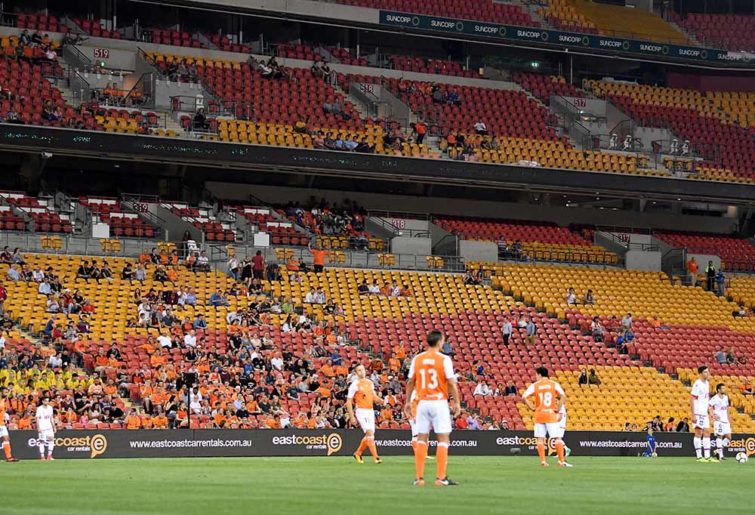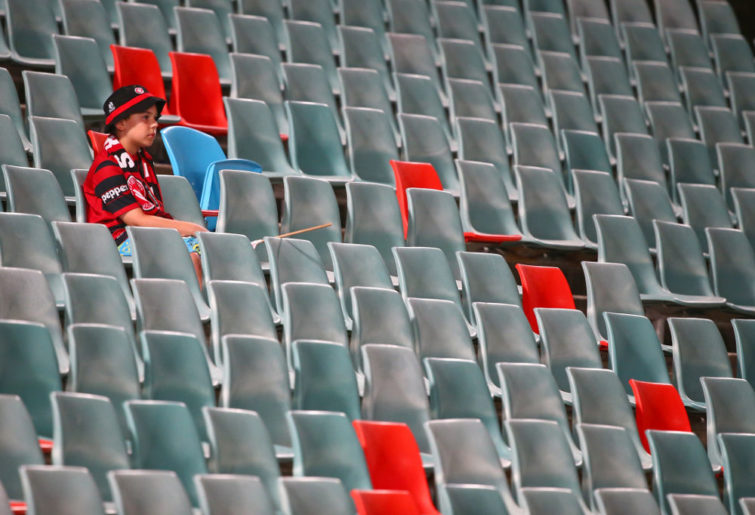Here is an analysis of each A-League club’s home attendances for the 2019-20 season up to Round 21 (1 March), before the COVID-19 pandemic affected crowds.
Adelaide (average home attendance of 8,584): This was Adelaide’s lowest average in its 15 seasons. Its two lowest attendances were Sunday 5:30 games played as the latter part of three home games in successive weeks.
One was the same time as the day-night test match at Adelaide Oval, the other on a 39 degree day. Adelaide also hosted a game on a 42 degree day and a game on a day of significant rain.
Brisbane (10,176): An improvement on the previous two seasons, but still its fifth-lowest overall. Brisbane was one of the most consistent teams for home attendances, drawing between 8-13,000 each game.
Two of Brisbane’s games were at Dolphin Stadium, which only has a capacity of 10,000; although the close-to-capacity atmospheres were widely praised.

A small crowd looks on to watch the Roar. (AAP Image/Darren England)
Central Coast (5,696): Perhaps only beat its lowest ever average from last season (5,562) because the season was suspended, but either way these last two seasons have been poor.
Central Coast had the most Sunday 6pm games (four), played its traditional New Year’s Eve clash on a 43 degree day, and had the fixture quirk of hosting Adelaide twice in little over a month.
Melbourne City (8,912): In its tenth season, City continued to be a low-drawing club. It had the fourth-highest membership tally (11,968), but only got crowds larger than 8,000 when it hosted Victorian opponents.
Without derbies, it averaged 6,655 – only better than Central Coast and Western United.
Melbourne Victory (17,617): Victory’s third-lowest season average likely correlated with its poor on-field performances. It had the fixture quirks of four home games in five weekends and hosting Wellington twice in little over a month. Lower crowds continued to be particularly noticeable at the cavernous Marvel Stadium.
Newcastle (7,386): This was Newcastle’s second-lowest season average. While it had the fifth-highest membership tally (10,344), it ranked ninth for attendances, which may reflect its early season losses.
Newcastle’s two lowest attendances were for a 5pm game on a 39 degree day and a game on a day of significant rain.
Perth (8,416): Perth’s fifth-lowest season average was not too much lower than its highest (10,533). It operates in a consistently low range of 7,500-10,500, whereby its highest season average is the lowest of the ten established A-League clubs.
This season, its lowest crowd was for a game played at the same time as the day-night test match at Optus Stadium, on a 41 degree day.
Sydney (12,999): A mid-range season for Sydney: acceptable if you consider it played at two smaller stadiums and therefore could not draw a large derby crowd; unacceptable if you consider the team’s impressive form.
Regardless, the reduced-capacity stadiums created a good atmosphere. Its lowest attendance was on a 36 degree day for its fourth home game in five weeks.
Wellington (8,730): This was Wellington’s third-highest season average, and best in ten years.
It was helped by strong attendances in Auckland, but this has also been the case in previous seasons. It is likely the strong on-field performances and attractive football were a factor. Its lowest crowd was a Sunday 6pm game.
Western Sydney (13,729): The Wanderers’ first season at its new ground started well, but the attendances decreased as the season progressed; likely related to the team’s middling form. Its lowest crowd was its only Sunday game, which kicked off at 6.30.

The A-League has struggled to attract crowds this season. (Photo by Mark Kolbe/Getty Images)
Noting the poor on-field form, it was a season that can be built upon, with a brilliant stadium and the second largest membership (17,325).
Western United (5,653): Some leeway must be given for a club’s first season; however, of the other ten current clubs, only Central Coast last season has had a lower season average. Not helping was the fact it had three home grounds – none of which are near its eventual main home – and hosted six games in eight weekends.
Overall, while this season’s A-League attendances were not great, it continues to respectably rank around 21st for global averages (beating Turkey, Poland, Sweden and South Korea). Plus, numbers are not everything. Arguably, the two crowds of just over 9,000 at Dolphin Stadium were the A-League at its atmospheric best.































































































